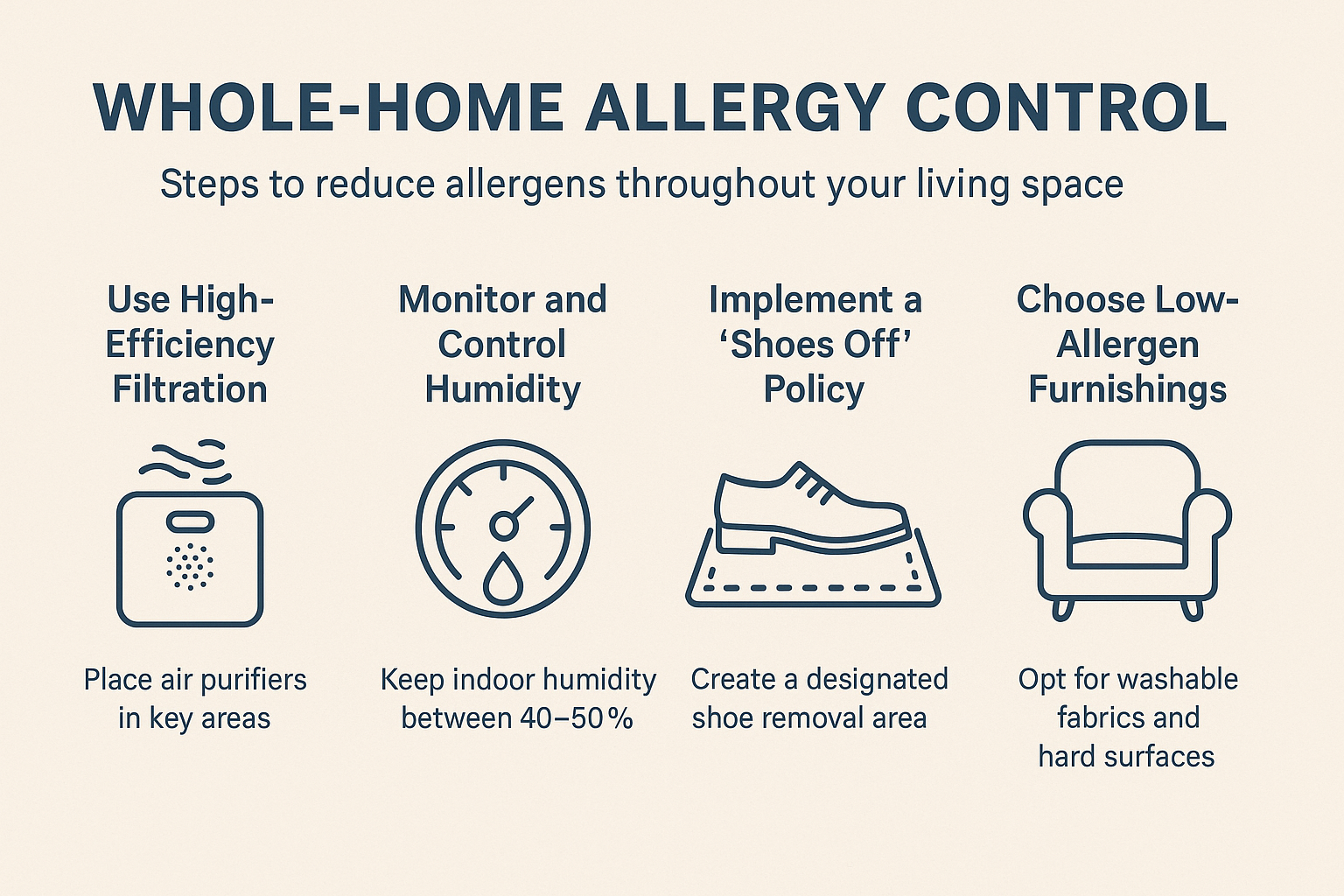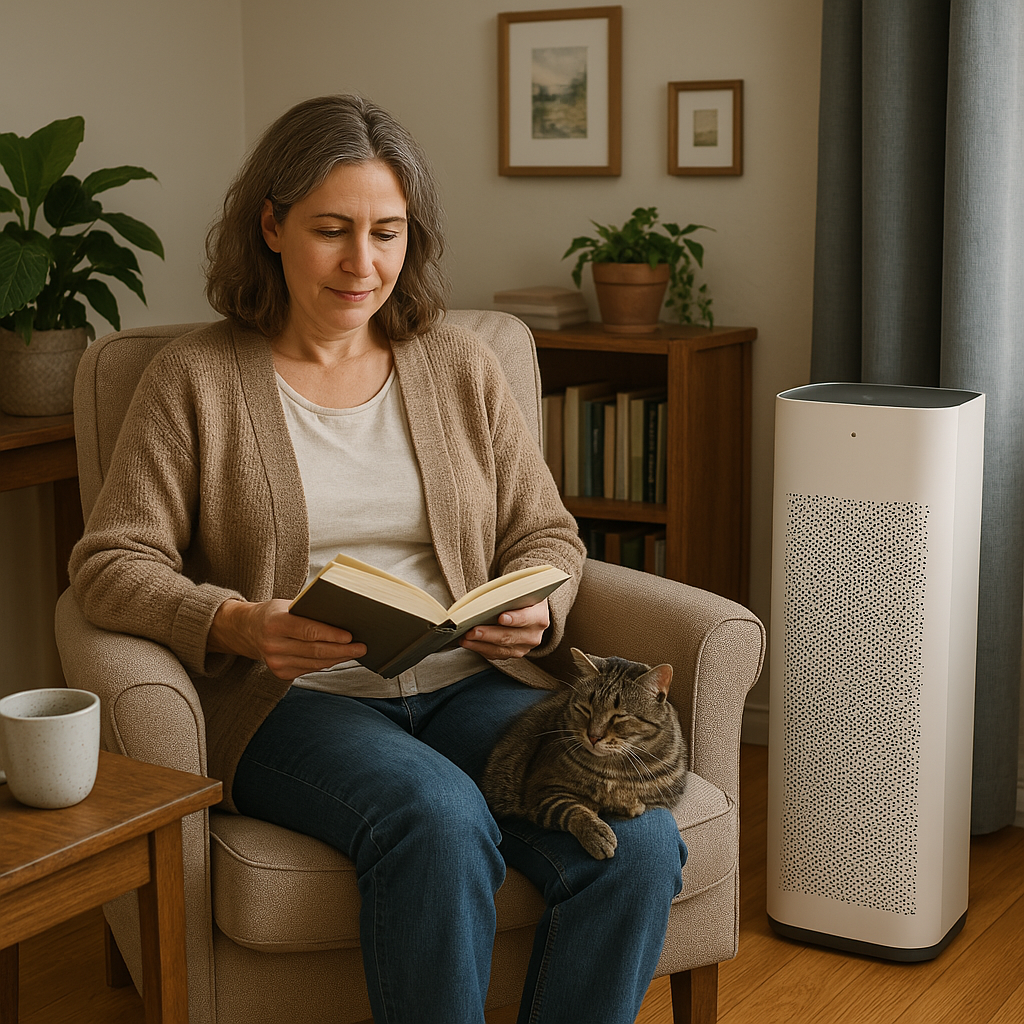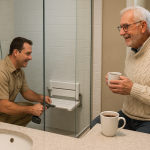Is your home making you cough or sneeze? For many people with allergies, the place where they should feel most comfortable can actually be a major source of discomfort. Learning how to allergy proof your home is essential if you or your family members suffer from sensitivities to dust, pet dander, mold, or pollen.
And for those of us planning to age gracefully, this isn’t just about comfort—it’s about protecting our health where we live, rest, and breathe each day. There is good news. With some thoughtful changes and simple habits, you can dramatically reduce indoor allergens and make it easier to breathe clean air at home.
This thorough guide will walk you through exactly how to take control of your indoor air quality, room by room. Whether you’re dealing with allergies yourself or living with someone who does, this checklist will help you to create a healthier aging in place environment.
The Whole-Home Approach to Allergy Control
Before diving into specific rooms, it’s important to understand that some allergy-proofing strategies benefit your entire home. These basic steps can make a significant difference in reducing allergens throughout your living space.
This simple visual breaks it down into four essential steps that make a real difference.

Use High-Efficiency Filtration Everywhere Possible
One of the most effective ways to allergy proof your home is to filter the air. Consider these important steps:
- Vacuum your home at least twice weekly with a vacuum that has a high-efficiency filter
- Place air purifiers in bedrooms and main living areas
- Look into whole-home air filtration options if your system supports it
- Replace your heating and cooling system filters regularly (every 1-3 months)
Air filtration catches tiny particles like pollen, dust mite waste, and pet dander before they can trigger your allergies. This simple step can dramatically improve indoor air quality.
“Allergy-Proofing Tip: Create a cozy allergy-safe space by combining an air purifier with low-dust décor, washable textiles, and pet-friendly surfaces. It’s a simple way to breathe easier—without sacrificing comfort.”
Monitor and Control Humidity Levels
Did you know that the moisture level in your home directly affects allergen growth? To allergy proof your home effectively:
- Maintain indoor humidity between 40% and 50%
- Use dehumidifiers in naturally damp areas, such as basements and bathrooms
- Run ventilation fans in kitchens and bathrooms during and after use
- Address any leaks or moisture issues immediately
Higher humidity encourages the growth of mold, mildew, and dust mites—three common allergy triggers. Keeping humidity in check is a simple but powerful way to reduce these allergens.
Implement a “Shoes Off” Policy
Your shoes track in more than just dirt. They also bring pollen, mold spores, and other outdoor allergens into your home. To allergy proof your home against these invaders:
- Create a dedicated shoe removal area just inside your entryway
- Use washable rugs or mats to capture debris before it spreads
- Provide slippers for family members and guests
- Set up a dedicated mat or paw-cleaning station at your entryway for pets
This small habit change can significantly reduce the amount of outdoor allergens that make their way into your living spaces.
Choose Low-Allergen Furnishings
The items you choose to fill your home with can either harbor allergens or help repel them. For an allergy-friendly home:
- Select hard flooring instead of wall-to-wall carpet
- Use washable area rugs that can be cleaned regularly
- Choose leather or easy-to-clean fabric furniture
- Replace heavy drapes with washable curtains
These choices reduce the places where allergens can hide and make it easier to keep your home clean.
How to Allergy Proof Your Bedroom
Since we spend approximately one-third of our lives sleeping, the bedroom should be your top priority when considering how to allergy proof your home. Creating an allergen-free sleep sanctuary can significantly improve your symptoms and sleep quality.
Use Allergen-Proof Bedding
Your bed can be a major source of allergen exposure. To create a cleaner sleep environment:
- Encase mattresses, pillows, and box springs in zippered allergy-proof covers
- Wash sheets, pillowcases, and blankets weekly in hot water (130°F/54°C)
- Clean pillows thoroughly every 3-6 months
- Choose hypoallergenic bedding materials
“Allergy-Proofing Tip: In the bedroom, use hypoallergenic mattress covers, wash bedding weekly in hot water, and keep pets off the bed. A quiet air purifier can also reduce allergens while you sleep.”
These steps are particularly important for controlling dust mites, which thrive in bedding and can trigger allergy symptoms.
Maintain Clean Bedroom Air
The air in your bedroom affects your breathing all night long. To keep it clean:
- Run an air purifier with a high-efficiency filter
- Keep windows closed during high pollen seasons
- Use smooth-surfaced blinds or washable curtains
- Dust surfaces with a damp microfiber cloth weekly
Clean air leads to better sleep and fewer allergy symptoms upon waking.
“When I started allergy-proofing my own bedroom, I was surprised by how much dust was hiding in decorative items and open shelves. I boxed up half of it, and within days, I was sleeping better and waking up less stuffy.”
Declutter Your Space
A cluttered bedroom collects more dust and makes cleaning difficult. To allergy proof your bedroom:
- Keep surfaces like nightstands and dressers clear
- Reduce decorative items that collect dust
- Store out-of-season clothing in sealed containers
- Minimize the number of stuffed animals on beds (wash these regularly if children have them)
Less clutter means fewer dust traps and easier cleaning, which is essential for managing allergens.
How to Allergy Proof Your Living Areas
“As someone who’s dealt with allergies for years, I’ve found that even small upgrades—like switching to a leather chair or vacuuming the couch weekly—make a real difference. It’s amazing how much dust and dander can live in the places we sit every day.”
Living rooms and family rooms are high-traffic zones where allergens settle into soft furnishings and can be stirred back into the air whenever people sit down or walk through.
Clean Upholstery and Rugs Regularly
Fabric surfaces trap allergens that can be released whenever you sit down. To keep these areas cleaner:
- Vacuum furniture and rugs at least twice weekly
- Consider steam cleaning upholstery every few months
- Choose washable throw pillows and blankets
- Opt for low-pile rugs that trap less dust
Regular cleaning prevents allergen buildup in the fabrics where you spend your leisure time.
Manage Pet Dander Effectively
If you have furry friends at home, their dander can be a significant allergy trigger. To reduce pet allergens:
- Groom and bathe pets regularly including their feet
- Keep pets out of bedrooms completely
- Use washable pet beds and clean them weekly
- Vacuum areas where pets spend time more frequently
- Dedicate one area for pet brushing
These practices help minimize pet allergens without giving up your beloved companions.
Ventilate Your Home Wisely
Fresh air is important, but timing matters when dealing with allergies:
- Open windows only when pollen counts are low
- Use air purifiers and fans instead during peak allergy seasons
- Clean window sills and tracks regularly to remove buildup
Smart ventilation helps you enjoy fresh air without inviting allergens inside.
How to Allergy Proof Your Kitchen
While not typically the dustiest room, your kitchen can harbor mold, food allergens, and moisture that contribute to allergy problems.
Prevent Mold Growth
Kitchens provide ideal conditions for mold to develop. To prevent this:
- Run an exhaust fan while cooking to remove moisture
- Wipe down counters and sinks regularly
- Clean under sinks and inside cabinets monthly
- Fix any leaks or dripping faucets promptly
Controlling moisture in the kitchen is key to preventing mold growth and related allergy symptoms.
Reduce Open Storage and Clutter
The organization of your kitchen affects how much dust and allergens it collects:
- Store food in sealed containers
- Limit open shelving that collects dust
- Clean appliance filters (refrigerator, range hood) monthly
- Wipe cabinet doors and handles regularly
A well-organized kitchen with minimal exposed surfaces is easier to keep allergen-free.
How to Allergy Proof Your Bathroom
Bathrooms can be breeding grounds for mold and mildew—two significant allergy triggers that thrive in moist environments.
Control Bathroom Moisture
The high humidity in bathrooms creates perfect conditions for allergens to grow:
- Use a dehumidifier or run an exhaust fan during and after showers
- Keep shower items like bottles and sponges dry between uses
- Choose mold-resistant shower curtains and liners
- Wipe down shower walls after use to reduce moisture
These simple habits can dramatically reduce the mold and mildew that trigger allergies.
Clean Bathroom Surfaces Thoroughly
Regular cleaning prevents allergen buildup in this moisture-prone area:
- Use cleaning products that don’t trigger sensitivities
- Wash towels and bath mats weekly in hot water
- Scrub tile and grout every 1-2 weeks to prevent mold
- Clean drains regularly to prevent buildup
A clean bathroom is less likely to harbor the mold and mildew that can trigger allergy symptoms.
Cleaning Tips That Make a Difference
The products and methods you use to clean can either help or hurt your allergy symptoms. Following these guidelines can help you clean more effectively without triggering reactions.
Choose Allergy-Safe Cleaning Products
Not all cleaning products are created equal when it comes to allergies:
Choose:
- Fragrance-free options
- Plant-based cleaners
- Products labeled “hypoallergenic” or “low-VOC”
Avoid:
- Harsh chemical cleaners
- Products with strong synthetic fragrances
- Aerosol sprays that can irritate airways
The right cleaning products remove allergens without adding irritants to your air.
Use Proper Dusting Techniques
How you dust matters just as much as how often you do it:
- Use microfiber cloths that trap dust instead of spreading it
- Avoid feather dusters or dry paper towels that scatter particles
- Work from top to bottom: ceilings, walls, furniture, then floors
- Dampen cloths slightly to better capture dust
Effective dusting removes allergens rather than redistributing them throughout your home.
Establish a Consistent Cleaning Routine
Consistency is key when learning how to allergy proof your home:
- Even 15-30 minutes of daily cleaning can keep allergens under control
- Vacuum floors and rugs regularly
- Dust surfaces weekly
- Wipe down high-touch areas like doorknobs and light switches
- Wash bedding and pet areas consistently
A regular cleaning schedule prevents allergen buildup and makes maintenance easier. If you’re managing allergies while aging in place, break tasks into shorter sessions over the week. The goal is consistency, not perfection.
✅ Weekly Allergy-Proofing Checklist for a Healthier Home
General Tasks
- ☐ Vacuum floors, rugs, and upholstery with HEPA filter
- ☐ Dust all surfaces with a damp microfiber cloth
- ☐ Run air purifiers (check filters monthly)
- ☐ Wipe doorknobs, switches, and remote controls
Bedroom
- ☐ Wash bedding in hot water
- ☐ Dust and declutter nightstands and dressers
- ☐ Run bedroom air purifier
- ☐ Keep windows closed during pollen season
Bathroom
- ☐ Run exhaust fan during and after showers
- ☐ Wipe down shower walls and tiles
- ☐ Wash bath mats and towels
- ☐ Clean sink, faucet, and drains
Pets (if applicable)
- ☐ Wash pet bedding
- ☐ Wipe paws after outdoor walks
- ☐ Vacuum pet areas more frequently
“Breathe easier, one room at a time.”
Extra Touches to Help Allergy Proof Your Home
Beyond the basics, these additional steps can further reduce allergens in your living space:
- Choose indoor plants carefully—some filter air while others produce pollen
- Avoid scented candles, incense, and air fresheners that can irritate airways
- Replace furnace and air conditioning filters according to manufacturer recommendations
- Keep windows closed on windy days or during high pollen seasons
- Consider removing carpeting if allergies are severe
These extra measures can make a significant difference for people with strong sensitivities.
Small Changes Lead to Big Relief
Learning how to allergy proof your home doesn’t mean turning your space into a sterile environment. It’s about creating a cleaner, more breathable, and more comfortable place for you and your family to enjoy.
Even small changes, like washing bedding more frequently or replacing heavy curtains with washable ones, can lead to noticeable improvements in how you feel—especially during peak allergy seasons.
Final Thoughts
Start with one room—most people begin with the bedroom—and gradually work your way through the rest of your home. Implement changes gradually, focusing on the areas where you spend the most time. Your sinuses, sleep quality, and overall wellbeing will thank you for the effort.
By following this guide on how to allergy proof your home, you’re taking an important step toward creating a healthier living environment. Remember that consistency is key, and even small improvements can make a big difference in managing allergy symptoms and breathing easier in your own space.






